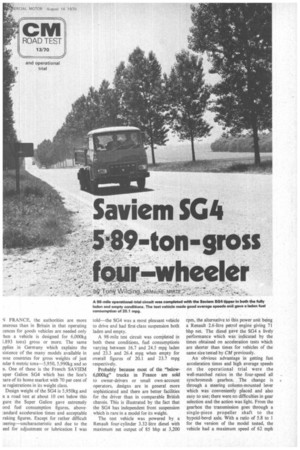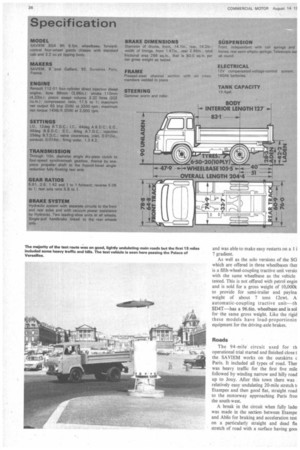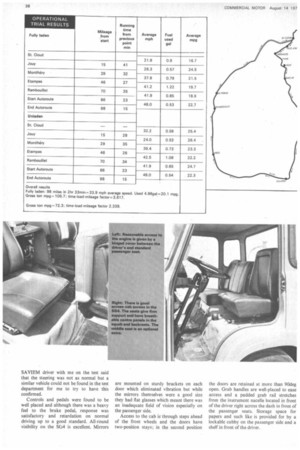Saviem SC', -ton-gross eeler
Page 37

Page 38

Page 39

Page 40

If you've noticed an error in this article please click here to report it so we can fix it.
by Tony Wilt:ling, mi-mect:IE' 11/118TE
A 98-mile operational-trial circuit was completed with the Saviem SG4 tipper in both the fully laden and empty conditions. The test vehicle made good average speeds and gave a laden fuel consumption of 20.1 mpg.
FRANCE, the authorities are more enerous than in Britain in that operating cences for goods vehicles are needed only hen a vehicle is designed for 6,000kg i.893 tons) grass or more. The same pplies in Germany which explains the Kistence of the many models available in lose countries for gross weights of just nder 6 metric tons-5,950, 5,990kg and so n. One of these is the French SAVIEM uper Galion SG4 which has the lion's are of its home market with 70 per cent of le registrations in its weight class.
Design weight of the SG4 is 5,950kg. and n a road test at about 10 cwt below this gure the Super Galion gave extremely ood fuel consumption figures, aboveLandard acceleration times and acceptable raking figures. Except for rather difficult eering—uncharacteristic and due to the eed for adjustment or lubrication I was told—the SG4 was a most pleasant vehicle to drive and had first-class suspension both laden and empty.
A 98-mile test circuit was completed in both these conditions, fuel consumptions varying between 16.7 and 24.5 mpg laden and 23.3 and 26.4 mpg when empty for overall figures of 20.1 and 23.7 mpg respectively.
Probably because most of the "below6,000kg" trucks in France are sold to owner-drivers or small own-account operators, designs are in general more sophisticated and there are better facilities for the driver than in comparable British chassis. This is illustrated by the fact that the SG4 has independent front suspension which is rare in a model for its weight.
The test vehicle was powered by a Renault four-cylinder 3.32-litre diesel with maximum net output of 85 bhp at 3,200 rpm, the alternative to this power unit being a Renault .2.6-litre petrol engine giving 71 bhp net. The diesel gave the SO4 a lively performance which was indicated by the times obtained on acceleration tests which are shorter than times for vehicles of the same size tested by CM previously.
An obvious advantage in getting fast acceleration times and high average speeds on the operational trial were the well-matched ratios in the four-speed all synchromesh gearbox. The change is through a steering column-mounted lever which was conveniently placed and also easy to use; there were no difficulties in gear selection and the action was light. From the gearbox the transmission goes through a single-piece propeller shaft to the hypoid-bevel axle. With a ratio of 5.8 to 1 for the version of the model tested, the vehicle had a maximum speed of 62 mph and was able to make easy restarts on a I i 7 gradient.
As well as the solo versions of the SG which are offered in three wheelbases ther is a fifth-wheel-coupling tractive unit versio with the same wheelbase as the vehicle tested. This is not offered with petrol engin and is sold for a gross weight of 10,000k to provide for semi-trailer and payloa weight of about 7 tons 12ewt. A automatic-coupling tractive unit--th SD4T—has a 96.6in. wheelbase and is sot for the same gross weight. Like the rigid these models have load-proportionin equipment for the driving-axle brakes.
Roads The 94-mile' circuit used for th operational trial started and finished close t the SAVIEM works on the outskirts c Paris. It included all types of road. Ther was heavy traffic for the first five mile followed by winding narrow and hilly road up to Jouy. After this town there was relatively easy undulating 20-mile stretch ti Etampes and then good flat, straight road to the motorway approaching Paris fron the south-west.
A break in the circuit when fully lade] was made in the section between Etampe and Ablis for braking and acceleration test. on a particularly straight and dead fla stretch of road with a surface having goo(
idhesion characteristics. Braking figures vere satisfactory but on the stops from 30 nph all wheels locked for most of the ;topping distance and there was a :onsiderable amount of bouncing and lopping from the rears. This must have :xtended the stopping distance from this ;peed at the same time as "building up– the fapley-meter reading to give a false -eading; from 20 mph there was only a ;mall amount of wheel locking.
On many parts of the route the road surface was extremely rough and it was here that the fine qualities of the suspension revealed themselves. I expected there to be a deterioration in the ride quality when unladen but was surprised to find virtually the same character.
The cab on the SG4 is fitted out to car standards and although a relatively small vehicle there was ample room for three men. Ventilation was found to be to a high standard also. The side windows had to be kept closed during the tests to stop fine sand being carried as a test load from blowing inside the cab but in spite of hot weather-75deg F (24deg C) ambient—the interior never got uncomfortable.
Steering The steering was the only point that did not match the other high qualities of the design. Almost continuous attention and frequent correction were needed to keep to a chosen line without wander; there was a feeling of "stickiness" and the steering was heavy. My impression was that lubrication or some small adjustment was needed. The
SAVIEM driver with me on the test said that the steering was not as normal but a similar vehicle could not be found in the test department for me to try to have this confirmed.
Controls and pedals were found to be well placed and although there was a heavy feel to the brake pedal, response was satisfactory and retardation on normal driving up to a good standard. All-round visibility on the SG4 is excellent. Mirrors are mounted on sturdy brackets on each door which eliminated vibration but while the mirrors themselves were a good size they had at glasses which meant there was an inadequate field of' vision especially on the passenger side.
Access to the cab is through steps ahead of the front wheels and the doors have two-position stays; in the second position the doors are retained at more than 90deg open. Grab handles are well-placed to ease access and a padded grab rail stretches from the instrument nacelle located in front of the driver right across the dash in front of the passenger seats. Storage space for papers and such like is provided for by a lockable cubby on the passenger side and a shelf in front of the driver.




























































































